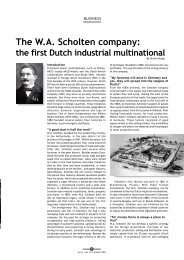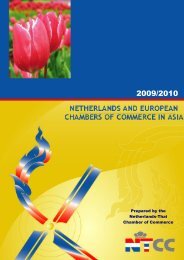January 2004 - Association of Dutch Businessmen
January 2004 - Association of Dutch Businessmen
January 2004 - Association of Dutch Businessmen
You also want an ePaper? Increase the reach of your titles
YUMPU automatically turns print PDFs into web optimized ePapers that Google loves.
FINANCIAL INSIGHT<br />
China: Threat or engine <strong>of</strong> growth?<br />
Jan Lambregts<br />
Economist / Strategist<br />
Rabobank<br />
A number <strong>of</strong> threats are supposed to originate from China. Flying accusations include the<br />
export <strong>of</strong> deflation, responsibility for manufacturing employment losses in the rest <strong>of</strong><br />
the world and manipulation <strong>of</strong> its currency for unfair trade advantages, much to the<br />
detriment <strong>of</strong> the US trade balance. Should the world be worried?<br />
China’s export <strong>of</strong> deflation just one <strong>of</strong> many deflationary forces in play<br />
China’s labor cost advantage over most other countries in the world is substantial. In an attempt to retain<br />
high levels <strong>of</strong> pr<strong>of</strong>itability, many Western and Japanese companies have tried to winter the economic downturn<br />
by aggressively cutting costs through a shift <strong>of</strong> (part <strong>of</strong>) their production facilities into China. The resulting<br />
downwards pressure on global prices compounded to the weak price environment <strong>of</strong> the economic downturn,<br />
which was in turn largely the result <strong>of</strong> the investment boom that preceded it. The spectre <strong>of</strong> a liquidity trap<br />
surfaced, but appears to have passed. While it is true that the China factor added to the risk <strong>of</strong> a liquidity<br />
trap at an unfortunate time, its cost deflation would normally be considered benign to consumers and<br />
overall was a relatively limited factor compared to other deflationary forces in play.<br />
Chart 1: Export deflation accusation may turn into export<br />
inflation 1<br />
Chart 2: What about China’s employment losses after Asian<br />
Crisis?<br />
Source: CEIC, Rabobank Research<br />
Source: CEIC, Rabobank Research<br />
1<br />
Official Chinese data series<br />
regularly draw heavy criticism<br />
for their unreliability. Since<br />
these are <strong>of</strong>ten the only data<br />
sources available on China, it<br />
is hard to escape using them.<br />
In particular the charts on<br />
export deflation/inflation and<br />
employment losses above<br />
should be interpreted with<br />
caution. The charts on trade<br />
are more reliable, while the<br />
charts on export/GDP and<br />
Hong Kong visitor arrivals draw<br />
their data from other sources.<br />
China will not absorb all manufacturing activity<br />
It cannot be denied that the reallocation <strong>of</strong> production facilities to China has hurt (employment in) certain<br />
industries and forces many countries to rethink their economic development strategies. The notion that<br />
China is about to absorb most <strong>of</strong> the world’s manufacturing activity, however, is too simplistic. First, China’s<br />
newfound capitalism is built on fragile fundamentals. The country still faces enormous challenges that will<br />
likely limit its potential to endlessly absorb manufacturing activity. Second, standard economic trade theory<br />
teaches us that allocation decisions are about comparative rather than absolute advantages. So while China<br />
may be the cheapest place to produce just about anything, it can be expected to specialize in those industries<br />
in which it is relatively speaking the most efficient, leaving plenty <strong>of</strong> other areas for other countries to<br />
specialize in. True, some industries and countries will face painful decisions; yet rather than investing<br />
energy in fighting these outcomes, countries ultimately stand to gain more from focussing on how best to<br />
position and benefit from the emerging Chinese economy.<br />
China not primarily to blame for large US trade deficit<br />
Various studies have shown the Chinese renminbi, which has de facto been pegged to the US dollar since 1994,<br />
to be undervalued by a range <strong>of</strong> 15-40% (REER basis). This has prompted the US to blame China for its growing<br />
trade deficit, claiming Chinese policymakers are using the peg to gain unfair trade advantages. A casual<br />
examination <strong>of</strong> the large bilateral trade deficit <strong>of</strong> the US with China would seem to confirm this, yet that road<br />
is too simplistic. The large US trade deficit with the world is the combined result <strong>of</strong> the US consumer living it<br />
large while the rest <strong>of</strong> the world has proven both willing to supply the products and plug the resulting financing<br />
18<br />
Vol.14 • No. 1 • <strong>January</strong> <strong>2004</strong>















